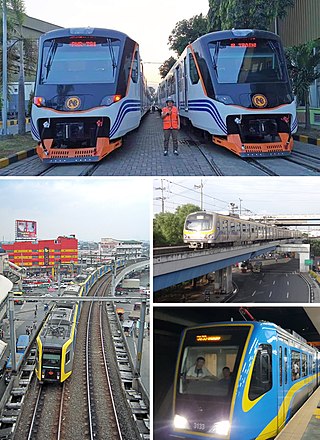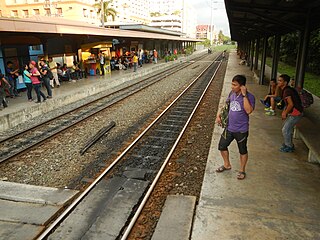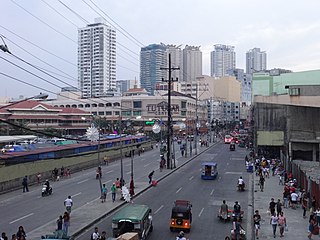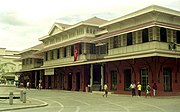
The Philippine National Railways (PNR) is a state-owned railway company in the Philippines which operates one commuter rail service between Laguna and Quezon, and local services between Sipocot, Naga and Legazpi in the Bicol Region. It is an attached agency of the Department of Transportation.

Rail transportation in the Philippines is currently used mostly to transport passengers within Metro Manila and provinces of Laguna and Quezon, as well as a commuter service in the Bicol Region. Freight transport services once operated in the country, but these services were halted. However, there are plans to restore old freight services and build new lines. From a peak of 1,100 kilometers (680 mi), the country currently has a railway footprint of 533.14 kilometers (331.28 mi), of which only 129.85 kilometers (80.69 mi) are operational as of 2024, including all the urban rail lines. World War II, natural calamities, underspending, and neglect have all contributed to the decline of the Philippine railway network. In the 2019 Global Competitiveness Report, the Philippines has the lowest efficiency score among other Asian countries in terms of efficiency of train services, receiving a score of 2.4, and ranking 86th out of 101 countries globally. The government is currently expanding the railway network up to 1,900 kilometers (1,200 mi) by 2022 through numerous projects.

Santa Mesa station is a railway station located on the South Main Line in the city of Manila, Philippines. It is one of two stations in the line to have its own access road.

Paco station is a railway station located on the South Main Line in the city of Manila, Philippines. It was originally opened by the Manila Railroad Company in 1908 as a major hub in the southern half of Manila, where trains toward Cavite province once operated. The old train station building was designed by William E. Parsons and was completed in 1915. Prior to the electrification plan in the late 1970s, Paco was the southernmost double-track station on the line.

Blumentritt station is a railway station located on the South Main Line in the city of Manila, Philippines. It is currently being repurposed as an elevated station of the under construction North–South Commuter Railway. It derives its name from nearby Blumentritt Road, which is named after the Bohemian professor Ferdinand Blumentritt, a friend of José Rizal and sympathizer of the Filipino cause.

Pasay Road station is a railway station located on the South Main Line in Makati, Metro Manila, Philippines. It is one of two stations in the line to have its own access road. It is named after Pasay Road, the old name of the Makati section of the adjacent Arnaiz Avenue.

FTI station is a railway station located on the South Main Line in Taguig, Metro Manila, Philippines. It is named after its major landmark, the grounds of the formerly state-owned Food Terminal, Inc. which is now renamed as Arca South.

Caloocan station is a railway station located on the North Main Line in Caloocan, Metro Manila, Philippines. It is rebuilt from its original location, now situated adjacent to the Caloocan railway depot, near Samson Road.

Claro M. Recto Avenue, more popularly known as simply Recto, is the principal commercial thoroughfare in north-central Manila, Philippines. It spans six districts just north of the Pasig River in what is generally considered as Manila's old downtown area.

The PNR Metro Commuter Line was a commuter rail line operated by the Philippine National Railways. It was first inaugurated as the Metro Manila Commuter Service in 1970, and originally served the North Main Line and the South Main Lines, as well as the defunct Carmona and Guadalupe branch lines. Since then, it adopted several names such as Metrotrak and Metrotren, before adopting its present name in the late 2000s. The line was also nicknamed the Orange Line due to its designation in the 1970s.
Tutuban station is a proposed Manila Light Rail Transit (LRT) station situated on Line 2. It is part of the Line 2 West Extension project, a 3.02-kilometer (1.88 mi) extension from Recto station to the Manila North Harbor in Tondo. The west extension project calls for the construction of three additional elevated stations: two on Recto Avenue and one on Zaragoza Street near Pier 4 of the Manila North Harbor. It was approved by the National Economic and Development Authority on May 19, 2015. Ayala Land Inc., will benefit the said station as they already acquired Tutuban Center. Future developments will soon progress at the area the same time with LRT Tutuban Station construction.

The North–South Commuter Railway, also known as the Clark–Calamba Railway, is a 147-kilometer (91-mile) commuter rail system under construction on the island of Luzon in the Philippines. Running from New Clark City in Capas, Tarlac, to Calamba, Laguna, with 36 stations and four services, the railway is designed to improve connectivity within the Greater Manila Area and will be integrated with the railway network in the region.

The PNR South Main Line is one of the two trunk lines that form the Philippine National Railways' network in the island of Luzon, Philippines. It was opened in stages between 1916 and 1938 by the Manila Railroad. Services peaked in the 1940s until the late 1960s, when the system started to decline. Since 1988, it was the only functioning inter-city rail after its counterpart to the north, the North Main Line, was closed. The intercity section of the line in Laguna, Quezon and the Bicol Region was then closed and reopened repeatedly between 2004 and 2014 due to a combination of declining ridership and was closed since then. Currently, only a little more than half of line is operational as the line currently serves two commuter services, namely the Inter-Provincial Commuter from San Pedro to Lucena and the Bicol Commuter regional rail service between Sipocot, Naga Camarines Sur and Legazpi Albay, following the closure of the main line, the PNR Metro Commuter Line between Tutuban station and Laguna.

Tutuban Center is a shopping complex and public transit hub in Manila, the Philippines that opened in 1993. It encompasses five retail buildings and a parking building in and around Manila's central train station located in the shopping precinct of Divisoria in Tondo district. The 20-hectare (49-acre) mixed-use development includes the original two-story brick and iron main terminal building of the Ferrocaril de Manila-Dagupan built in 1887, a declared national historical building by the National Historical Commission of the Philippines since 1934. It also includes the Bonifacio Plaza fronting the old terminal building on Recto Avenue where a statue of Andrés Bonifacio was erected in 1971. Its integrated mall complex houses a mix of wholesale and retail bazaars and covers only 8.5 hectares of the total 20-hectare development. The complex will house the interchange station between the proposed North–South Commuter Railway and an extension of the Manila Light Rail Transit System Line 2 according to the masterplan submitted by the Japan International Cooperation Agency in 2015. Its redevelopment plan also entails the construction of several mixed-use buildings, including office towers, residential buildings, hotels, a convention center, and a 300-metre (980 ft)-high observation tower to be known as the Tower of Maynila.
College Station is a railway station located on the South Main Line in Los Baños, Laguna, Philippines.

The PNR South Long Haul, also known as the PNR Bicol, is a stalled inter-city rail line project in southern Luzon, Philippines. It is part of the larger Luzon Rail System, a network of long-distance standard-gauge lines being built by the Philippine National Railways throughout Luzon. It is one of the two lines that will reconstruct the historic PNR South Main Line, along with the electrified North–South Commuter Railway South section to Calamba, Laguna.

The PNR North Main Line is one of the two trunk lines of the Philippine National Railways in the island of Luzon, the other being the PNR South Main Line. The line during its maximum extent led to various cities and municipalities in Central Luzon and the Ilocos Region.

Rail transportation in the Greater Manila Area is a major part of the transportation system in Metro Manila and its surrounding areas. The railway network, collectively known as the Greater Capital Region Railway System, consists of the Manila Light Rail Transit System (LRT), Manila Metro Rail Transit System (MRT), and Philippine National Railways lines within the region.

The Manila Railway 70 class of 1908 was a class of at least twenty-two 0-6-2 side and well-tank locomotives built by the North British Locomotive Company. These locomotives were first put into service on a mainline during the late 1900s and early 1910s by the Manila Railway Company. Their primary purpose was to support the growing network and replace the aging Dagupan class engines. They were used on all the lines of the Manila Railway and its succeeding incarnation, the Manila Railroad. Over time, some locomotives were either scrapped or given to sugarcane plantations after being withdrawn. The last unit, No. 79, remained in service with the Pampanga Sugar Development Company as late as 1989.





































